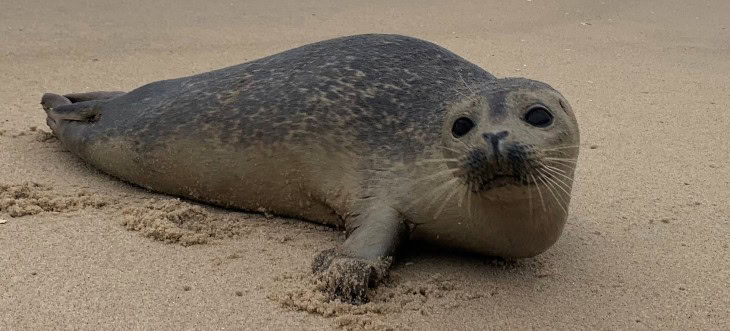by Alison Mitchell, Co-Executive Director, New Jersey Conservation Foundation
New Jersey’s cutest seasonal visitors are back – seals from New England and Canada who swim south each winter to follow their food sources. With their big eyes, long whiskers and almost comical resting poses, seals resemble well-fed puppies. In fact, they’re sometimes called “sea dogs.”
Harbor seals – the most common seals in our waters – began arriving at their winter colony in Sandy Hook over a month ago, and will soon be spreading out to beaches and waterways up and down New Jersey’s coast. Gray seals will follow in January and February, and could be joined by rarer harp, ringed and hooded seals from the arctic.
“They’re following the fish, they’re following the water temperature,” explained Michele Pagel, assistant director of the Brigantine-based Marine Mammal Stranding Center (MMSC), which for over 40 years has been rescuing seals that are injured, sick, malnourished, or exhausted.
The MMSC cautions residents about the importance of giving seals plenty of distance – for the health and safety of the seals, as well as that of humans and their canine companions.
Hunting for fish and crustaceans is hard work, and even with their waterproof fur and insulating blubber, seals must “haul out” of the water regularly to rest and warm up in the sun. Coming too close to seals can scare them into going back in the water prematurely, causing them to deplete precious energy reserves. Even being in a state of increased vigilance can prevent them from getting the rest they need.
Not to mention the fact that seals are wild animals, and can attack with sharp teeth and claws if they feel threatened. “They’re federally protected (by the 1972 Marine Mammal Protection Act), so people should stay at least 150 feet away – or farther if the seal notices you,” says Pagel.
In November, the Marine Mammal Stranding Center held a “Pup Strut” in Brigantine to educate dog walkers who frequent Jersey shore beaches about what to do if they encounter seals. “Dog lovers are some of our biggest advocates for the seals,” noted Pagel. “We tell them to always keep their dogs on a leash on the beach, because your dog is always going to smell the seal long before you see it.”
People who spot a seal hauled out on their local beach are urged to call MMSC’s 24-hour hotline at (609) 266-0538, even if the seal doesn’t appear to be in distress. “We’d rather know about a seal that’s perfectly healthy than not know about a seal that’s not healthy,” says Pagel.
The MMSC has over 400 volunteers who are trained to recognize subtle signs of distress that casual observers might miss. For example, healthy seals are likely to rest in the curved “banana pose,” with head and rear flippers uplifted, while a seal lying in a flattened position may need help.
If volunteers determine that a hauled-out seal on the beach is fine, they will stay near the animal, for hours if necessary, to make sure that people and pets don’t approach. Volunteers are so dedicated that many return to the same spot the following morning to check up on the seal.
Seals found to be in need of medical care are taken to the Marine Mammal Stranding Center’s hospital. Staff and volunteers have responded to as many as 15 seal sightings in a single winter day, and they treat conditions ranging from parasites and respiratory problems to boat propeller cuts, shark bites and embedded fish hooks.
Young seals often end up in the MMSC hospital because they are underweight or exhausted. Gray seal pups are born in January and February in coastal New England and Nova Scotia, and are fed and cared for by their mothers for only about two weeks before being left to fend for themselves.
“The pups will swim anywhere from 400 to 900 miles to get to New Jersey,” said Pagel. In addition to being exhausted from their journey, pups may be malnourished due to underdeveloped hunting skills. “We get some pups who haven’t quite figured things out for themselves.”
Another species, harp seals, have been hospitalized after eating beach sand – mistaking it for snow, which they consume in their arctic habitat to get water.
If you want to see seals for yourself this winter, your best bet is to visit the Sandy Hook unit of Gateway National Recreation Area at low tide. Seals can usually be spotted on Skeleton Island in Sandy Hook Bay, or on the rocks near Officers’ Row. Make sure to bring binoculars or a camera with a telephoto lens, as the seals won’t be close.
If you’re walking along the beach this winter and spot a seal, keep your distance and call the MMSC. In addition to sending volunteers to evaluate the animal and protect them from encroachment, MMSC offers coastal communities free “Give Seals Space” signs to put up near beaches.
For more information about the Marine Mammal Stranding Center, including seals the organization is currently treating or has recently released, go to the organization’s website at https://mmsc.org/ or Facebook page at www.facebook.com/njmarinemammal.
To learn more about seals, visit the National Oceanic and Atmospheric Administration (NOAA) website at www.fisheries.noaa.gov/seals-sea-lions.
And for information about preserving New Jersey’s land and natural resources – including wildlife – visit the New Jersey Conservation Foundation website at www.njconservation.org or contact me at [email protected].

